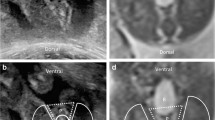Abstract
The value of radiography, ultrasound and magnetic resonance imaging (MRI) in detecting skeletal and intraspinal pathology was assessed in infants with anorectal malformations, and the need for spinal MRI examination in this group of patients was evaluated. Twenty-one infants were examined with radiography, ultrasound and MRI of the lower spine. The detection of skeletal and intraspinal abnormalities was compared for the three imaging modalities. Fifteen patients were normal in all three examinations. Radiography showed bony skeletal abnormalities in six children, although sometimes very subtle. By ultrasound both bony and cartilaginous malformations were detected in all six patients and by MRI in five patients. Five of the six children with skeletal abnormalities had intraspinal pathology, detected in all cases by ultrasound and MRI. However, the abnormalities were more clearly demonstrated by MRI than by ultrasound. Spinal radiographs must be examined carefully for abnormalities, because they can indicate the presence or absence of intraspinal pathology. Normal radiographic and sonographic appearance of spinal anatomy in children with anorectal malformation makes MRI superfluous, but if radiographs or ultrasound are abnormal, MRI should be used to accurately depict possible intraspinal pathology.
Similar content being viewed by others
References
Berdon WE, Hochberg B, Baker DH, Grossman H, Santulli TV (1966) The association of lumbosacral spine and genitourinary anomalies with imperforate anus. Am J Radiol 98: 181–191
Thompson W, Grossman H (1974) The association of spinal and genitourinary abnormalities with low anorectal anomalies (imperforate anus) in female infants. Radiology 113: 693–698
Carson JA, Barnes PD, Tunell WP, Smith EI, Jolley SG (1984) Imperforate anus: the neurologic implication of sacral abnormalities. J Pediatr Surg 19: 838–842
Tunell WP, Austin JC, Barnes PD, Reynolds A (1987) Neurora-diologic evaluation of sacral abnormalities in imperforate anus complex. J Pediatr Surg 22: 58–61
Pang D (1993) Sacral agenesis and caudal spinal cord malformations. Neurosurgery 32: 755–779
Karrer FM, Flannery AM, Nelson MD, McLone DG, Raffens-perger JG (1988) Anorectal malformations: evaluation of associated spinal dysraphic syndromes. J Pediatr Surg 23: 45–48
Keating MA, Rink RC, Bauer SB, Krarup C, Dyro FM, Winston KR, Shillito J, Fisher EG, Retik AB (1988) Neurourological implications of the changing approach in management of occult spinal lesions. J Urol 140:1299–1301
Filston HC, Oakes WJ (1991) Occult spinal dysraphism in patients with anal agenesis. J Pediatr Surg 26:1001–1005
Warf BC, Scott RM, Barnes PD, Hendren WH (1993) Tethered spinal cord in patients with anorectal and urogenital malformations. Pediatr Neurosurg 19: 25–30
Stephens FD, Smith ED (1986) Classification, identification, and assessment of surgical treatment of anorectal anomalies. Pediatr Surg Int 1: 200–205
Gryspeerdt GL (1963) Myelographic assessment of occult forms of spinal dysraphism. Acta Radiol 1: 702–717
Barkovich AJ, Raghavan N, Chuang S, Peck WWC (1989) The wedge-shaped cord terminus: a radiographic sign of caudal regression. Am J Neuroradiol 10:1223–1231
Nievelstein RAJ, Valk J, Smit LME, Vermeij-Keers C (1994) MR of the caudal regression syndrome: embryologic implications. Am J Neuroradiol 15:1021–1029
Beek FJA, Bax KMA, Mali WPTM (1994) Sonography of the coccyx in newborns and infants. J Ultrasound Med 13: 629–634
Li L, Li Z, Wang LY, Xiao FD (1993) Anorectal anomaly: neuropathological changes in the sacral spinal cord. J Pediatr Surg 28: 880–885
Nelson MD, Sedler JA, Gilles FH (1989) Spinal cord central echo complex: histoanatomic correlation. Radiology 170: 479–481
Author information
Authors and Affiliations
Rights and permissions
About this article
Cite this article
Beek, F.J.A., Boemers, T.M.L., Witkamp, T.D. et al. Spine evaluation in children with anorectal malformations. Pediatr Radiol 25 (Suppl 1), S28–S32 (1995). https://doi.org/10.1007/BF03545576
Received:
Accepted:
Published:
Issue Date:
DOI: https://doi.org/10.1007/BF03545576




